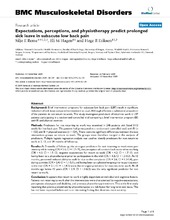| dc.contributor.author | Reme, Silje Endresen | |
| dc.contributor.author | Hagen, Eli Molde | |
| dc.contributor.author | Eriksen, Hege Randi | |
| dc.date.accessioned | 2010-09-16T13:15:07Z | |
| dc.date.available | 2010-09-16T13:15:07Z | |
| dc.date.issued | 2009-11-13 | eng |
| dc.Published | BMC Musculoskeletal Disorders 10(139) | en |
| dc.identifier.issn | 1471-2474 | |
| dc.identifier.uri | https://hdl.handle.net/1956/4188 | |
| dc.description.abstract | Background: Brief intervention programs for subacute low back pain (LBP) result in significant reduction of sick leave compared to treatment as usual. Although effective, a substantial proportion of the patients do not return to work. This study investigates predictors of return to work in LBP patients participating in a randomized controlled trial comparing a brief intervention program (BI) with BI and physical exercise. Methods: Predictors for not returning to work was examined in 246 patients sick listed 8-12 weeks for low back pain. The patients had participated in a randomized controlled trial, with BI (n = 122) and BI + physical exercise (n = 124). There were no significant differences between the two intervention groups on return to work. The groups were therefore merged in the analyses of predictors. Multiple logistic regression analysis was used to identify predictors for non return to work at 3, 12, and 24 months of follow-up. Results: At 3 months of follow-up, the strongest predictors for not returning to work were pain intensity while resting (OR = 5.6; CI = 1.7-19), the perception of constant back strain when working (OR = 4.1; CI = 1.5-12), negative expectations for return to work (OR = 4.2; CI = 1.7-10), and having been to a physiotherapist prior to participation in the trial (OR = 3.3; CI = 1.3-8.3). At 12 months, perceived reduced ability to walk far due to the complaints (OR = 2.6; CI = 1.3-5.4), pain during activities (OR = 2.4; CI = 1.1-5.1), and having been to a physiotherapist prior to participation in the trial (OR = 2.1; CI = 1.1-4.3) were the strongest predictors for non return to work. At 24 months age below 41 years (OR = 2.9; CI = 1.4-6.0) was the only significant predictor for non return to work. Conclusion: It appears that return to work is highly dependant on individual and cognitive factors. Patients not returning to work after the interventions were characterized by negative expectations, perceptions about pain and disability, and previous physiotherapy treatment. This is the first study reporting that previous treatment by physiotherapists is a risk factor for long-term sick leave. This has not been reported before and is an interesting finding that deserves more scrutiny. | en_US |
| dc.language.iso | eng | eng |
| dc.publisher | BioMed Central | eng |
| dc.rights | Attribution CC BY | eng |
| dc.rights.uri | http://creativecommons.org/licenses/by/2.0/ | eng |
| dc.title | Expectations, perceptions, and physiotherapy predict prolonged sick leave in subacute low back pain | eng |
| dc.type | Peer reviewed | |
| dc.type | Journal article | |
| dc.description.version | publishedVersion | |
| dc.rights.holder | Copyright 2009 Reme et al; licensee BioMed Central | |
| dc.rights.holder | Reme et al. | eng |
| dc.identifier.doi | https://doi.org/10.1186/1471-2474-10-139 | |
| dc.identifier.cristin | 346234 | |
| dc.subject.nsi | VDP::Samfunnsvitenskap: 200::Psykologi: 260 | nob |

